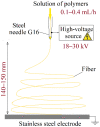Study of the Nanofibers Fabrication Conditions from the Mixture of Poly(vinyl alcohol) and Chitosan by Electrospinning Method
- PMID: 35215724
- PMCID: PMC8963080
- DOI: 10.3390/polym14040811
Study of the Nanofibers Fabrication Conditions from the Mixture of Poly(vinyl alcohol) and Chitosan by Electrospinning Method
Abstract
Nanofiber fabrication is attracting great attention from scientists and technologists due to its applications in many fields of life. In order to design a nanosized polymer-based drug delivery system, we studied the conditions for the fabrication of electrospun nanofibers from poly (vinyl alcohol) (PVA) and chitosan (CS), which are well-known as biocompatible, biodegradable and non-toxic polymers that are widely used in the medical field. Aiming to develop nanofibers that can directly target diseased cells for treatment, such as cancerous cells, the ideal choice would be a system that contains the highest CS content as well as high quality fibers. In the present manuscript, it is expected to become the basis for improving the low bioavailability of medicinal drugs limited by poor solubility and low permeability. PVA-CS nanofibers were obtained by electrospinning at a PVA:CS ratio of 5:5 in a 60% (w/w) acetic acid solution under the following parameters: voltage 30 kV, feed rate 0.2 mL/h, needle-collector distance 14 cm. The obtained fibers were relatively uniform, with a diameter range of 77-292 nm and average diameter of 153 nm. The nanofiber system holds promise as a potential material for the integration of therapeutic drugs.
Keywords: biomaterials; chitosan; electrospinning; fiber technology; poly (vinyl alcohol).
Conflict of interest statement
The authors declare no conflict of interest.
Figures









References
-
- Taylor G. Disintegration of Water Drops in an Electric Field. Proc. R. Soc. London. Ser. A Math. Phys. Sci. 1964;280:383–397. doi: 10.1098/rspa.1964.0151. - DOI
-
- Zairy H.M., El-Zairy E.M. In: Chitosan as A Biomaterial—Structure, Properties, and Electrospun Nanofibers, Concepts, Compounds and the Alternatives of Antibacterials. Bobbarala V., editor. IntechOpen; London, UK: 2015. pp. 81–101. - DOI
Grants and funding
LinkOut - more resources
Full Text Sources
Miscellaneous

